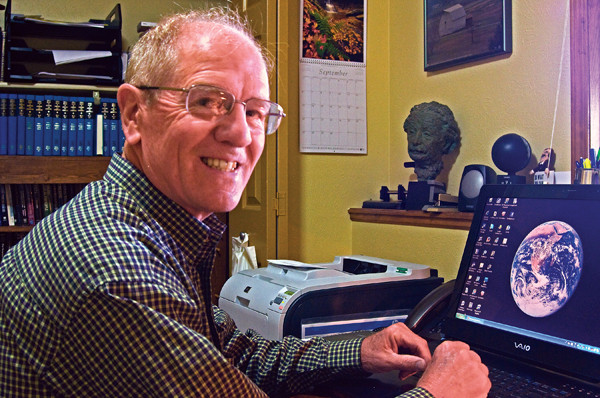
by George A. Seielstad Friday, December 28, 2012

George Seielstad
The largest migration of megafauna the world has ever experienced is under way — but it is going unnoticed. The reason? We’re too involved: The massive migration is that of humans moving from the countryside to cities. In 2008, for the first time in history, more than half the world’s people lived in cities, and the United Nations projects that percentage to grow to 60 percent by 2030. The pace of urbanization has been rapid and steeply climbing: In 1800, 3 percent of people lived in cities; in 1900, it was 13 percent; in 1950, it was 29 percent; and in 2005, it was 49 percent. That equates to 2.5 billion people added to urban populations in the last half of the 20th century. The single most important reason behind humans’ staggering migration is opportunity — but how long will that opportunity continue? Are we dooming ourselves or will we innovate, adapt and continue to prosper?
Today, 468 metro areas exceed 1 million people and 25 exceed 10 million. Tokyo’s metropolitan area leads the way with more than 34 million people. Population densities are also exceptional. Cairo, Egypt, leads the world with more than 6.8 million people packed into its 214-square-kilometer core, with approximately 32,000 people per square kilometer. Delhi and Kolkata, India, are not far behind with 30,000 and 28,000 people per square kilometer, respectively. Current annual growth rates for those three cities, in order, are 2.6, 4.6 and 2 percent. Even in the U.S., New York City has an eye-popping density of 10,000 people per square kilometer (8.4 million people spread over 789 square kilometers).
For millennia, people have moved to cities for the promise of better opportunities. Cities are centers of innovation, knowledge creation, wealth creation, specialized services and entertainment. Most importantly, they offer jobs. Wages and bank deposits per person are higher in cities. Cities also allow greater social mobility. The mix of diverse social communities, a product of migrations, is an endless source of cultural innovation. Most trends in music, art, fashion and language begin in urban settings. These advantages scale with the size of a city’s population, regardless of where in the world the city is located.
But there is a downside. Cities are major sources of crime, pollution and disease, problems that also scale with population growth. The newest migrants to the world’s most rapidly growing cities typically wind up in slums, where clean water and sanitation are often absent. Hoped-for job opportunities are often scarcer than anticipated.
A central question at this critical historical moment, when civilization must turn toward sustainability, is whether humanity’s parade to cities is environmentally sound. A 2007 study led by theoretical physicist Luis Bettencourt of Los Alamos National Laboratory in New Mexico and published in the Proceedings of the National Academy of Sciences showed that such migration may well be the best environmental choice. Cities occupy only 0.3 percent of total land area and only 3 percent of arable land. Furthermore, physical infrastructure — electrical cables, gasoline stations, roads, communications networks and the like — is shared by more people, so less infrastructure is needed per person than in widely dispersed populations, Bettencourt and his colleagues point out.
But here is the catch: Cities thrive or perish depending upon their ability to foster nonstop innovations. Take Merv, Turkmenistan, possibly the largest city in the 12th century. “It is axiomatic that such an oasis would eventually be turned into a dust bowl,” travel writer Paul Theroux once wrote. “In the course of time, all great cities and their kings … turn into dust … They remain a crumpled example of the vanity of human wishes.”
Today’s challenge is greatly magnified because the pace of innovation to which cities must respond or wither is accelerating. The acceleration of innovation’s treadmill is illustrated by these timelines for how long it took these new technologies to be adopted by 150 million people: the telephone, 89 years; television, 38 years; cell phone, 14 years; iPod, seven years; Facebook, five years; Internet, four years; Google Earth and Skype, two years. With technologies and consumer demands changing so rapidly, not all cities will be able to keep up. In the U.S., for example, the three cities that showed the steepest population declines in the year ending July 1, 2009, according to the U.S. Census Bureau, were Cleveland, Ohio, and Detroit and Flint, Mich. For all three, the annual decline continued a population loss recorded in every year of the decade. All three cities prospered when steel and heavy manufacturing were important components of the U.S. economy, but as these industries shifted to foreign countries (for better or worse) and a global recession crippled them further, their inability to adapt and innovate quickly enough left them vulnerable. Now they are in a race to avoid the fate of Merv.
The point is that while some cities continue to attract great numbers of migrants in the future, others will fall back faster than ever in the competition for the “next great thing.” Given the acceleration of technology, this may be happening faster than we realize. So the question is: Will modern cities continue to adapt? Will cities' advantages in physical infrastructure inch us closer to sustainability? Can cities innovate at an ever-accelerating pace to provide opportunities for the hordes that choose to live in them? Or is Merv’s dust-to-dust path the example all will eventually follow?
© 2008-2021. All rights reserved. Any copying, redistribution or retransmission of any of the contents of this service without the expressed written permission of the American Geosciences Institute is expressly prohibited. Click here for all copyright requests.